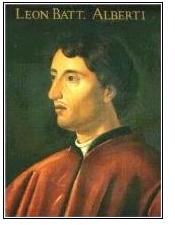 Battista Alberti (who took the additional name Leon later in his life) belonged to one of the influential banker families of Florence. When Alberti was born Florence was controlled by the rival Albizzi family, and the Alberti were in exile in Genoa.
Battista Alberti (who took the additional name Leon later in his life) belonged to one of the influential banker families of Florence. When Alberti was born Florence was controlled by the rival Albizzi family, and the Alberti were in exile in Genoa.Italian humanist, architect and art theorist of the Renaissance, b. 14 February 1404 (Genoa, Italy), d. 25 April 1472 (Rome).
 Battista Alberti (who took the additional name Leon later in his life) belonged to one of the influential banker families of Florence. When Alberti was born Florence was controlled by the rival Albizzi family, and the Alberti were in exile in Genoa.
Battista Alberti (who took the additional name Leon later in his life) belonged to one of the influential banker families of Florence. When Alberti was born Florence was controlled by the rival Albizzi family, and the Alberti were in exile in Genoa.
Battista and his elder brother Carlo were illegitimate children of Lorenzo Alberti and a widow from Bologna. They were Lorenzo's only children and had a good home and stepmother, who Lorenzo had married when Battista was four years old.
When Battista turned 10 or 11 he entered boarding school in Padua and began his classical training in earnest. He became so skilled in Latin that at the age of 20 he wrote a Latin comedy which was often considered a discovered work of ancient Roman literature - it was still published as a Roman comedy in 1588, more than 100 years after Alberti's death.
Alberti's education continued at the University of Bologna, where he studied law without much enthusiasm. His father died before he graduated, and members of the family took hold of his inheritance. But Battista persevered despite sudden poverty and received his doctorate in canon law in 1428.
Alberti decided not to follow a legal career and make use of his literary skills instead. He received a commission to rewrite the lives of the Christian saints and martyrs in elegant "classical" Latin. In 1432 he accepted the position of secretary to the Papal Chancery in Rome. For the rest of his life Alberti occupied various positions of the church, which provided for his livelihood.
But Alberti's intellect was much too active to concentrate on religious matters. His studies of the ancient Roman civilization had given Alberti a sense for a secular and rational, ordered world. He found the perfect complement in his early mathematical training from his father. The combination of ordered thought with scientific methods were the essence of the new citizen, and Alberti is often seen as its best example, the prototype of the Renaissance "universal man."
Alberti's achievements began with his treatise Della famiglia ("On the family") of 1432, a work on moral philosophy. Written in Tuscan dialect for the "non literatissimi citadini" (not very literate citizens) rather than Latin, it covered issues such as adversity and prosperity, husbandry, friendship, family, education and responsibilities to society, stressing always the moral value of work above mere thought. It was the elegant formulation of the new bourgeois ethics, which found virtue no longer in the contemplative detachment of the feudal classes but derived its moral values from work.
The treatise made Alberti known throughout Italy's cities, and he made many friends among the leading personalities of the time. In Florence Brunelleschi had just rediscovered the art of perspective drawing. Using his mathematical skills Alberti systematized the rules of perspective in his work Della pittura ("On Painting") of 1435 with an affectionate acknowledgment of Brunelleschi. Painters of the Renaissance took to the new science immediately, and some of the masterpieces of the century that followed show its application to great effect.
Collaboration with the Florentine Paolo Toscanelli (the geographer and cosmologist who had given Columbus his map of the world) led to a treatise on geography, the first such work in the European civilization since the time of ancient Rome. Based on the recent rediscovery of geometric mapping in the works of Ptolemy it described the mathematical principles of surveying and mapping and the instruments used to that purpose.
Possibly the greatest impact of Alberti's works is, however, in architecture. Again Alberti combined the study of the classics, this time the works of Vitruvius (architect to the Roman emperor Augustus) with mathematics. The result was his massive theoretical work De re aedificatoria ("Ten books on architecture"), finished in 1452 and published posthumously in 1485.
The work had an equally profound influence on architecture as Della pittura had on painting. It developed a theory of proportionality and harmony from the style of classical Roman buildings that determined Renaissance aesthetics, and it summarized Roman engineering knowledge and developed it further.
During the last 20 years of his life Alberti became a practicing architect, and his buildings defined the revival of the classical Roman style. He was the architectural adviser to Pope Nicholas V and contributed to the first plans for the new Saint Peter's Basilica.
Among all the personalities of the Renaissance Leonardo da Vinci was the only one to develop a similar breadth of knowledge and intellect. Leonardo's poor upbringing did not give him the chance of Alberti's classical education; he was therefore driven in his studies by the practical aspects of his work. Alberti was the more systematic theoretical thinker, Leonardo the more practical genius.
Kelly-Gadol, J. (1995)Leon Battista Alberti. Encyclopaedia Britannica 15th ed.